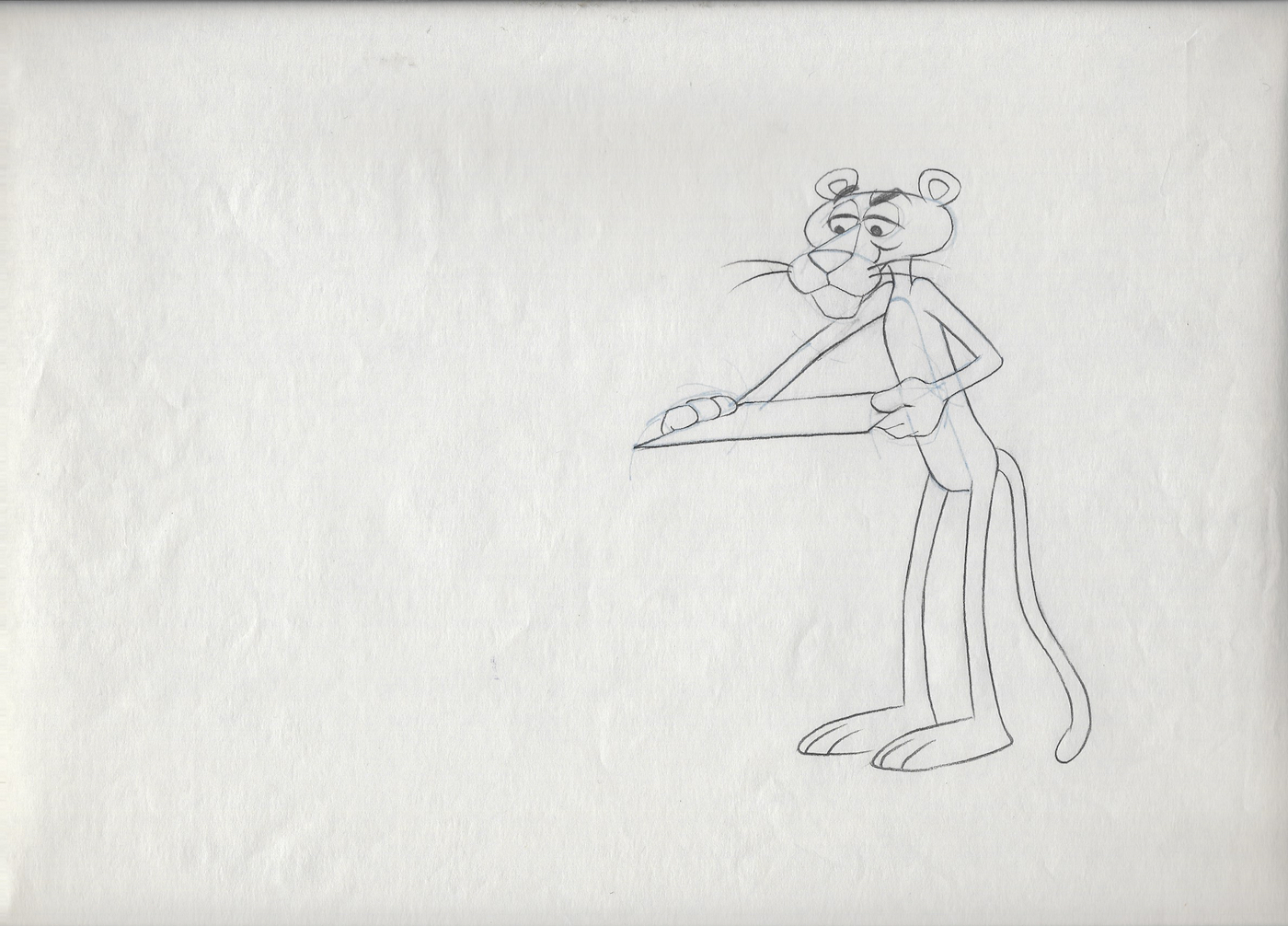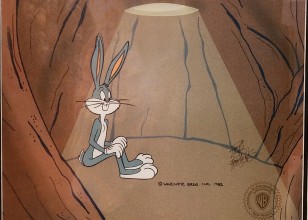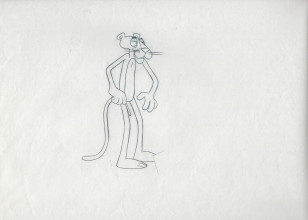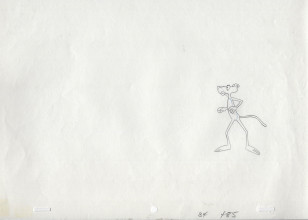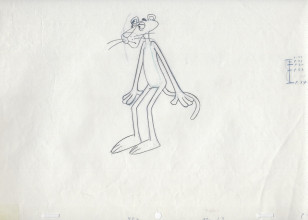Product Description
This Pink Panther original production drawing is from 1971's The New Pink Panther Show. It was purchased directly from the director Friz Freleng in 1989, when he was still alive.
The New Pink Panther Show Pink Panther was originally created for the 1971 cartoon short, but was also used in Freleng's show The Pink Panther Show, which was created through DePatie-Freleng Studios between 1969 and 1980.
Here's a screen cap of the drawing from The New Pink Panther Show:
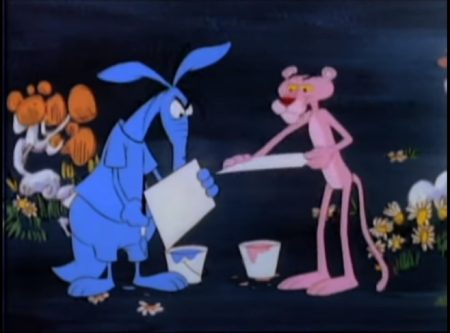
Thanks to Todd Federman for help in ID'ing all these Pink Panther drawings. It's great to know Pink Panther experts :). He also supplied the screen cap!
Check out all the Pink Panther art HERE.
About Pink Panther:
Animation historian Jerry Beck has called the Pink Panther "the last great Hollywood cartoon character", noting that "Classic animation pretty much died in the '60s, everyone had kind of bailed out. But his creators didn't rest on their laurels. They didn't make the cartoons to look like Warner Bros. cartoons, or Disney cartoons, or the UPA look of Mister Magoo and Gerald McBoing-Boing. They came up with their own clever new style. The only other important cartoon of the '60s was Yellow Submarine."
The Pink Panther was a notable contribution to the animation art form. Top animation directors such as Hawley Pratt, Gerry Chiniquy, Robert McKimson, and Sid Marcus contributed to a distinctive style, supported by master story writer John W. Dunn. Produced after theatrical cartooning's golden age of the 1940s and 50s, they were constrained to the limited animation techniques applied to Saturday morning cartoons of the 1960s and after. Within these limitations, the Pink Panther made creative use of absurd and surreal themes and visual puns and an almost completely wordless pantomime style, set to the ubiquitous Pink Panther theme and its variations by Henry Mancini. The overall approach is reminiscent of the classic silent movies of Charlie Chaplin and Buster Keaton.
About Friz Freleng:
Friz Freleng, credited as I. Freleng early in his career, was an American animator, cartoonist, director, producer, and composer known for his work at Warner Bros. Cartoons on the Looney Tunes and Merrie Melodies series of cartoons. In total he created more than 300 cartoons.
He introduced and/or developed several of the studio's biggest stars, including Bugs Bunny, Porky Pig, Tweety, Sylvester, Yosemite Sam (to whom he was said to bear more than a passing resemblance), and Speedy Gonzales. The senior director at Warners' Termite Terrace studio, Freleng directed more cartoons than any other director in the studio (a total of 266), and is also the most honored of the Warner directors, having won five Academy Awards and three Emmy Awards. After Warner closed down the animation studio in 1963, Freleng and business partner David H. DePatie founded DePatie–Freleng Enterprises, which produced cartoons (including The Pink Panther Show), feature film title sequences, and Saturday-morning cartoons through the early 1980s.
The nickname "Friz" came from his friend, Hugh Harman, who initially nicknamed him "Congressman Frizby" after a fictional senator who appeared in satirical pieces in the Los Angeles Examiner, due to the characters strong resemblance to him. Over time, this shortened to "Friz".
Warner Bros. Cartoons was closed in 1963, leading Freleng to take a job at Hanna-Barbera Productions as story supervisor on their first feature, Hey There, It's Yogi Bear! Freleng rented the same space from Warners to create cartoons with his now-former boss, producer David H. DePatie (the final producer hired by Warner Bros. to oversee the cartoon division), forming DePatie–Freleng Enterprises. When Warner decided to reopen their cartoon studio in 1964, due to Freleng asking them if he can rent the studio, eventually settling for $500, they did so in name only; DePatie–Freleng produced the cartoons into 1966.
The DePatie–Freleng studio's signature achievement was The Pink Panther. DePatie–Freleng was commissioned to create the opening titles for the feature film The Pink Panther (1963), for which layout artist and director Hawley Pratt and Freleng created a suave, cool cat character. The Pink Panther cartoon character became so popular that United Artists, distributors of The Pink Panther, had Freleng produce a short cartoon starring the character, The Pink Phink (1964).
After The Pink Phink won the 1965 Academy Award for Best Short Subject (Cartoons), Freleng and DePatie responded by producing a whole series of Pink Panther cartoons. Other original cartoon series, among them The Inspector, The Ant and the Aardvark, Tijuana Toads, The Dogfather, Roland and Rattfink and Crazylegs Crane, soon followed. In 1969, The Pink Panther Show, a Saturday morning anthology program featuring DePatie–Freleng cartoons, debuted on NBC. The Pink Panther and the other original DePatie–Freleng series would remain in production through 1980, with new cartoons produced for simultaneous Saturday morning broadcast and United Artists theatrical release.
Layout artist Hawley Pratt, who worked at DePatie–Freleng during the time, is credited with the creation of Frito-Lay's Chester Cheetah, on the Food Network show "Deep Fried Treats Unwrapped", though some sources say it was DDB Worldwide, while others credit Brad Morgan. The studio is also known for creating the color opening title sequence for the I Dream of Jeannie television series. DePatie–Freleng also contributed special effects to the original version of Star Wars (1977), particularly the animation of the lightsaber blades, which was done by Korean animator Nelson Shin.
By 1967, DePatie and Freleng had moved their operations to the San Fernando Valley. Their studio was located on Hayvenhurst Avenue in Van Nuys. One of their projects, titled Goldilocks, featured Bing Crosby and his family, and had songs by the Sherman Brothers. At their new facilities, they continued to produce new cartoons until 1980, when they sold DePatie–Freleng to Marvel Comics, which renamed it Marvel Productions.

